|
Summer on the Hill
Summer on the HillBy Lisa Gonzales Temperatures are up, school is out, and you’re still in town? Then join in the activities being organized for the young-at-heart of all ages this summer. Mentor an intern, take your kids to camp, and attend lectures on a wide range of science topics. Summer Lecture Series 2003
The one-hour lectures are geared to a general audience and are open to all Lab employees, summer students, teachers, and visitors. The lectures are held at noon in the Building 50 auditorium. Science Exploration Camp Space is still available for the Summer 2003 Science Exploration Camp. Children entering second through sixth grades may participate in any of the six-week-long sessions being held from July 14 through Aug. 22. The camp mixes science and recreation activities centered around weekly themes, such as “Rocks, Sand and Soil” and “Seeing Through a Lens.” The core hours of the science camp are 9 a.m. to 4 p.m., with a morning science component and afternoon recreational activities. The science component will be held on the Hill and includes field trips to locations such as as the Lawrence Hall of Science, the UC Botanical Gardens, the Chabot Space and Science Center, and the Explorato-rium. Recreational activities will include trips to local parks and the Memorial Glade, swimming twice a week, and visits to campus museums. Transportation will be provided by LBNL buses, UC charter buses and public transportation. Before- and after-camp care is included in the fees. Every effort will be made to accommodate parents who begin work before 8 a.m. The registration fee is $215 per week. Positions are still open for college-age counselors who would like to gain job experience working with children. Parents are also encouraged to participate by presenting a science module or accompanying campers on outings. For more information, job application requirements, and registration see the camp website at http:// sciencecamp.lbl.gov/. Summer Internships Eighty undergraduate research fellows will be matched with members of the scientific staff for 10 weeks in a program designed to provide research experience across the sciences. Of these, 16 interns are part of a preservice teacher program in which participants have decided on a teaching career in science, math, or technology. The undergraduate internship program runs from June 9 through Aug. 15, and will conclude with a poster session. Thirty high school students from as far away as Stockton will spend six weeks from June 18 through Aug. 1 interning in the scientific and operations divisions, gaining work experiences in science, computing sciences, technology and related areas. A few mentors are still needed for some of the students selected to participate in the six-week High School Student Research Participation Program. If interested, contact Rollie Otto at X5325 or Joe Crippen at X5816. The Lawrence Hall of Science
The Lawrence Hall of Science kicks off its summer events with the grand opening of “Forces that Shape the Bay,” with a special family event the weekend of June 21–22. This permanent outdoor exhibit will enable visitors to participate in activities that show how the Bay was formed, or view the result of millions of years of geologic, climatic, marine, and human forces. The exhibit includes telescopes to greatly enhance the spectacular view of the Bay and beyond, facilitator-led, hands-on activities, and geologic marvels such as a waterfall, erosion tables, earthquake and plate tectonics simulators. The Hall of Science is also offering several day camps for young people
with topics like “Bugs, Beetles, and Butterflies” and “Blocks,
Beams, and Bridges,” as well as residential camps at Yosemite and
Tahoe National Forest. For more information, see http://www.lhs.berkeley.edu. ALS Art Show Draws a Crowd
The ALS Inspires Art Students On May 15 UC Berkeley students displayed their recent artistic creations on the outdoor patio of the Advanced Light Source. The students — from the art, architecture, and engineering departments on campus — had spent two evenings at the ALS painting and drawing at various locations around the experiment floor. The result of their efforts was a colorful array of artistic impressions — everything from wiring and monochromators to the historic ALS dome. For ALS staff this was a rare opportunity to see their environment through the fresh eyes of young artists, and for the students it was an intriguing glimpse into the big research facility up on the hill.
Liz Moxon of the ALS and David Attwood of Materials Sciences organized the event along with Professor Joe Slusky of UC Berkeley's Department of Architecture. Berkeley Lab's Community Relations provided transportation for the students. If you missed the exhibit, the images will be exhibited in San Francisco
later this summer during the Eighth International Conference on Synchrotron
Radiation (SRI 2003) at Yerba Buena Center for the Arts.
|
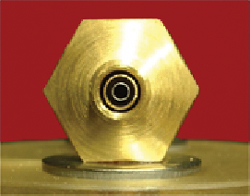 |
Duo Wang, a scientist in the Environmental Energy Technologies Division, developed the technology with assistance from Mark Modera, the scientist who developed the original sealing system for residences. Carrier Aeroseal has licensed the system for exclusive use in sealing ducts in commercial buildings.
Modera and his colleagues developed the aerosol-based technology for sealing the ducts of heating, ventilating, and air-conditioning (HVAC) systems in residential and small commercial buildings in the 1990s. Their research showed that homes with ducts in contact with outside air wasted on average of 20 percent of all heating and cooling energy because of leaky ducts. They pioneered a system that could seal these ducts remotely and inexpensively using an aerosol that is injected into the ducts through a home’s heating register. The aerosol flows through the system, gradually building up a flexible seal at holes, tears, and other duct leaks.
The team successfully tested the technology in the field and licensed
it to a start-up company, Aeroseal, which was eventually acquired by Carrier
Corporation. Residential duct sealing that uses the Berkeley Lab technology
is available through contractors trained by Carrier.
Commercial buildings
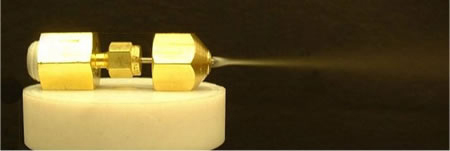 |
| The prototype induced-cooling pneumatic atomizer is made with standard tube fittings. |
The research by Modera and his colleagues also suggested that energy losses in the ducts of large commercial buildings are probably as large as those in private homes. Although research continues at Berkeley Lab to quantify these losses in commercial buildings, scientists here estimate that sealing ducts in these buildings could potentially save billions of BTUs of natural gas and billions of kilowatt-hours of electricity. (A BTU, or British thermal unit, is the heat required to raise the temperature of a pound of water by one degree Fahrenheit.)
Large commercial buildings present special problems that the residential sealing technology cannot address.
“The HVAC duct system in large buildings typically has a large trunk duct system, and a number of smaller sub-duct systems connected to it,” says Wang. “Trunk duct systems are longer and have a larger cross-section than residential systems, and they are connected to many branched duct systems. One problem is that large aerosol particles from a residential-scale duct sealer would fall out of the air stream too quickly to seal leaks effectively in these larger commercial ducts. Another problem is that the branch systems often contain heating or cooling coils that cannot be exposed to aerosol sealants.
“To increase the flow of aerosol sealant in larger ducts, we designed a sealing system that uses a number of compact aerosol injectors,” Wang continues. “Several of these are installed along the trunk line of a commercial building duct, injecting aerosol simultaneously. This substantially increases the sealing rate of leaks in the duct system.”
A new aerosol atomizer
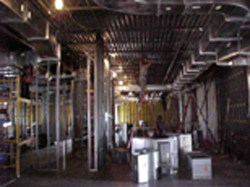 |
| Scientists have come up with a solution to improve the aerosol sealing of ducts in large commercial buildings, which present special problems that the residential sealing technology could not address. |
The researchers developed new technology to adapt the aerosol-based sealer to commercial buildings. The induced-cooling pneumatic atomizer is a spray nozzle that converts the sealant into an aerosol and sends it flowing into the duct system. The commercial system needed a nozzle that could inject sealant at a smaller spray angle and a higher flow rate. Not finding an appropriate commercially available nozzle, the research team developed their own design, which provided the right particle size and flow rate at the correct spray angle, without clogging.
MASIS consists of a sealing-process monitoring system and portable injectors. In one design, each unit contains an air compressor and a cart that carries an aerosol sealant injector wand, a liquid sealant tank, a peristaltic pump, a control box, and a dedicated toolbox. In another design, the injectors are all fed by a central station and are daisy-chained via umbilical cords.
To seal the trunk system, injectors are installed along the duct and are run simultaneously. To seal the branch duct systems, injectors are installed downstream of the heating and cooling coils, which are usually located in variable air volume (VAV) boxes. Each branch seals independently, and all of the injectors can operate simultaneously.
The induced-cooling atomizer is licensed to Aeroseal only for aerosol duct sealing. Licenses are still available for other applications, such as drying product dehydration, drying waste streams, and atomizing liquids for industrial processes.
By Ron Kolb
Revised policies on Laboratory-hosted meetings have been developed in
order to clarify what have been some historically confusing guidelines.
The results should be better documentation and control while reducing
risks to the Lab, according to Conference Services manager Carol Johnson.
“We hope that by more clearly defining lines of accountability and
allowable costs, we will see a more responsible adherence to Lab and Department
of Energy policies,” Johnson said. “We’ve had instances
of improper handling of money, activities that appeared to be unallowable,
or simply inadequate documentation which came to light during recent audits
and self-assessment reviews.”
Effective this week, the new policy will include the following revisions:
CONUS rates, to be approved by Conference Services.
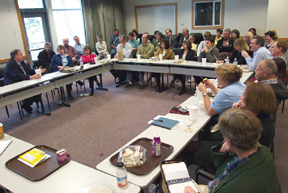 |
As before, Lab-hosted meetings must be property authorized, reported and reimbursed, and costs must be “reasonable and prudent.” Unallow-able costs under the DOE-Berkeley Lab contract include promotional items and memorabilia, alcoholic beverages, entertainment, and decorative items.
No approval is needed for routine onsite meetings that do not involve food service. Division approval is sufficient for light refreshments. The division director or designee is responsible for approving requests for meal service and offsite meetings prior to the request being forwarding to Conference Services.
Offsite meetings will only be approved by Conference Services if the cost analysis is sound and additional benefit accrues to the Laboratory by “providing an environment that will facilitate training and/or work-related discussions.” The policy specifically discourages meetings “in resort-type locations or facilities unless careful analysis of the alternative, that clearly favors that site selection, is documented.”
The entire policy can be found in the Regulations and Procedures Manual (RPM) 1.07. The new language streamlines the definition of a laboratory-hosted meeting — “an event or activity during which Laboratory employees, contractors, guests, and/or visitors hold work-related discussions. These meetings may include training, contract negotiations, project reviews, or public briefings when meals are provided during the meeting.”
The Conference Services website provides a summary of the guidelines and offers downloadable forms to request food service and off-site meetings. There is also a link to the current CONUS per diem rates.
Full-service meeting and conference coordination is also offered by Conference Services. These services include site selection, vendor negotiations, budgets, communication, catering, technical setup, registration, on-site coordination and accounting. Customized online registration websites with the ability to accept credit card registrations, arrange housing, and select meals or activities can also be provided.
These optional services are recharged to the divisions on an hourly
basis.
For further information contact ConferenceServices@lbl.gov.
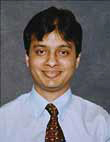 |
| Satish Kumar |
Satish Kumar of the Lab’s Environmental Energy Technologies Division
was honored last week with the Energy Service Professional of the Year
award from the the Association of Energy Engineers. Kumar was recognized
for his work in developing the International Performance Measurement and
Verification Protocol (IPMVP), which provides an overview of current best
practice techniques available for measuring and verifying energy savings
resulting from the implementation of energy and water conservation measures,
both in existing buildings and in new constructions.
Deputy Director Sally Benson has formed a task force that will help chart the future of the Engineering Division at Berkeley Lab. In the face of large project funding fluctuations, Berkeley Lab is challenged to provide a stable staffing environment for engineers while providing state-of-the-art technical expertise to partners internal and external to the Laboratory.
The planning group is chaired by Kem Robinson and includes representatives from Engineering and from its present and potential partner divisions. Peter Denes and Roderich Keller are coleaders of the task force.
“We are going to define a new consensus vision for Engineering,” Benson said. “Engineering Division Director Jim Triplett and the division leadership have already taken the first step in preparing a strategic plan. This task force offers the opportunity to broaden the input and endorsement of the plan throughout the Laboratory.”
An open, one-day plenary meeting is being scheduled for June at a time and place to be announced. Presentations will be made by Benson, Robinson, Engineering Division Director Triplett, Engineering department heads, and partner divisions.
The task force will explore considerations such as expertise, funding, management, and staffing needs necessary to allow the Engineering Division to fulfill its mission and contribute to making Berkeley Lab the premier choice for scientific research. Models from other organizations will be considered.
Its report is due September 1.
Task Force members includes Alan Biocca, Alessandro Ratti, Daryl Oshatz, Henrik Von Der Lippe, Jian Jin, Ross Schlueter, all from Engineering; Damir Sudar of Life Sciences, Helmuth Spieler of Physics, Howard Padmore of the Advanced Light Source, John Corlett of Accelerator and Fusion Research, Robert Shoenlein of Materials Sciences, and Jane Baynes of the Deputy Director’s Office. There will be representatives from Genomics and Earth Sciences/Environmental Energy Technologies on the Task Force as well.
By Dan Krotz
Three is better than two, according to Berkeley Lab researchers who’ve
debunked a longstanding assumption concerning how hydrogen molecules break
apart and adhere to a catalyst surface.
Using scanning tunneling micro-scopy, the team determined that groups
of three or more vacancies on a palladium surface are required to facilitate
a process called dissociative hydrogen adsorption, in which a hydrogen
molecule separates into two hydrogen atoms, each of which then occupy
a vacancy.
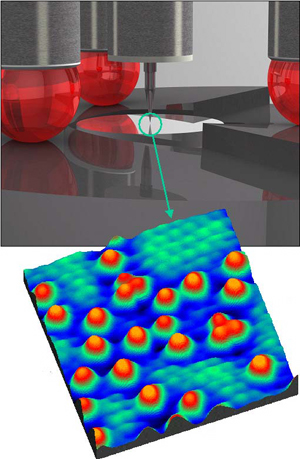 |
| Vacancies appear as red bumps in this scanning tunneling microscope image of a palladium surface. The two three-vacancy clusters, one located near the top and one on the right, can facilitate hydrogen adsorption. |
Their research, reported in the April 17 issue of Nature, counters the widely held belief that only a pair of vacancies is needed to trigger hydrogen adsorption. The discovery may prompt scientists to rethink the underlying principles that drive many industrially important catalytic processes, such as those used in gasoline reformulation and hydrogen fuel cells.
“This paper is a call to theorists,” says Miquel Salmeron,
a physicist with Berkeley Lab’s Materials Sciences Division. “It
reveals that we don’t fully understand catalysis, even in simple
systems.”
Catalyst surfaces supply chemical reactions with atoms. In a hydrogen
fuel cell, for example, a metal surface adsorbs hydrogen atoms from a
gas such as methane, and supplies these atoms to an electrochemical reaction
that generates electrical power. But although adsorption is a cornerstone
of hundreds of catalytic processes, it is only partially understood. Researchers
know that in order for a molecule to break apart and adsorb onto a catalyst
surface, it must find a home among the surface’s constantly fluctuating
mix of atoms. If the molecule can’t find this home, or active site,
it bounces off.
Researchers also know that in many cases these active sites are composed of atom-free vacancies. Called atomic adsorption sites, these vacancies jitterbug across a catalyst surface, sometimes moving alone, sometimes forming short-lived clusters of two, three, or more. Every so often, this random dance brings together enough vacancies to create a home for a hydrogen molecule — a phenomenon at the heart of how catalyst surfaces work, and also where scientists’ understanding becomes hazy. For years, they believed an active site needs only as many vacancies as the number of atoms in a molecule. To adsorb a hydrogen molecule’s two atoms, only two vacancies must momentarily pair up. This assumption is repeated in many textbooks, and it makes sense — one vacancy for each atom — but it’s wrong.
The truth didn’t reveal itself until Salmeron and colleagues trained a scanning tunneling microscope onto a catalyst surface made of palladium. The microscope detects individual atoms, or the absence of atoms, using a probe that tapers down to a point only a single atom across. This atom-tipped probe skims across a surface, always maintaining the same current between it and the surface atoms. If the probe moves over an atom with an electron cloud that facilitates electronic conduction, it rises up. If it moves over an atom with an electron cloud that does not favor conduction, such as a hydrogen atom, the probe drops down. These irregularities are fed into a computer that produces an atom-by-atom contour map of the surface.
Salmeron’s team used this special microscope to observe the formation of sites that adsorb hydrogen. They cooled a palladium surface to an extremely low temperature, which slows its atomic movement, and exposed it to hydrogen molecules. They then watched what happened. Like a bird’s eye view of people mish-mashing their way through a crowded train station, the vacant atomic adsorption sites skitter across the surface. When two vacancies bump together, creating the condition scientists long believed is ripe for hydrogen adsorption, nothing happens. The two vacancies merely dance together for a fraction of a second, then part ways.
“Although the pair of vacancies are constantly bombarded with hydrogen molecules, they never adsorb hydrogen atoms,” Salmeron says. “This proves that two vacancies don’t work.”
But when three vacancies cluster together, two vacancies in the group quickly accept a hydrogen atom. This sequence of images, from a cluster of three vacancies to two adsorbed hydrogen atoms and one remaining vacancy, marks the first time the formation and function of an active site has been observed. The same holds true when the microscope captures four vacancies clustered together: hydrogen atoms soon fill two vacancies, leaving two remaining vacancies. Based on these images, the Berkeley Lab team concludes hydrogen adsorption requires active sites containing three or more vacancies. Why this is so, however, remains unanswered.
“We haven’t solved a mystery. We’ve only unveiled
a mystery,” Salmeron says. “Two vacancies don’t work,
three or more are needed. Now it’s up to the theoreticians to explain
why.”
In addition to Salmeron, Toshi Mitsui, Mark Rose, Evgueni Fomin, and Frank
Ogletree of the Materials Sciences Division contributed to the research.
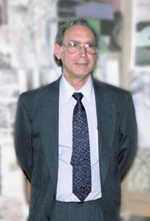 |
Advanced Light Source Division Director Daniel Chemla and Materials Scientist Alex Pines were among several scientists who paid tribute to the late Iran Thomas of the Department of Energy’s Office of Science at a special symposium held May 28-29. Thomas, who passed away on Feb. 28, was the director of the division of Materials Sciences and Engineering in the Office of Basic Energy Sciences (BES) from 1987 until his death. For the last seven years of his tenure as division director, Thomas also served as deputy director of BES.
“Iran was indeed an extraordinary man. He had a humility coupled
with an eye for, and appreciation of, quality and vision, that were, and
remain, truly rare,” said Alex Pines.
The memorial symposium, entitled “BES Science 2018: A Future Retrospective”
was held in Arlington, Virginia. Attendees briefly reminisced about the
more than 15 years of Thomas’ accomplishments. But more importantly,
they looked to the future, as Thomas did. Speakers were asked to place
themselves in the year 2018, on what would have been Thomas’ 80th
birthday, and offer a retrospective on the past 15 years. Chemla discussed
the growth of BES science in materials sciences, chemistry, and biosciences.
And Pines discussed imaging with magnetic fields.
According to the symposium’s website, this forward-looking retrospective
challenges both the scientific communities and the federal agencies to
achieve this future.
The “retrospective” also serves as a fitting way to remember Thomas. The symposium’s website describes Thomas as “a visionary, a planner, a doer. He challenged himself, and he challenged others to think big, to plan big, and to depart from the path of the traveled. Iran was a champion of interdisciplinary research when science was still practiced within the bounds of disciplines. He recognized the importance of widely accessible world-class facilities for science when these facilities were still the province of a few specialists. Through skillful management and unrelenting persistence, he enabled the development of new and innovative research programs and some of the world’s most powerful scientific user facilities that now dot the Nation’s landscape from New York to California.”
The symposium was held in conjunction with the Spring BES Advisory Committee (BESAC) meeting.
By Lisa Gonzales
Earlier this month, members of Berkeley Lab’s Latino and Native
American Association (LANA) held a ceremony to honor two of its 2003 scholarship
recipients. Established to create and maintain a sense of cultural awareness
for its members and the Lab community, LANA awarded three $500 scholarships
to Latino and Native American students this year.
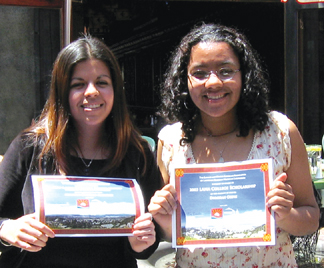 |
| Winners of the LANA scholarships include Monica Orozco-Alcaraz of Richmond High School (left) and Deborah Ortiz of Berkeley High. |
“Latino and Native American youth are constantly being stereotyped as uneducated, lazy, or lawless. This perception is not only untrue, but it is hurtful as well,” says LANA member Robert Torres of the Facilities Division. “We felt that we had an obligation to show our young people how much we appreciate their hard work. These scholarships are a way to do this.”
In keeping with this spirit, Betty Armstrong of the Physics Division established a new scholarship in memory of her mother, Frances May Watts Hobby, who came from a strong line of educators. This scholarship was awarded to Monica Orozco-Alcaraz of Richmond High School. Orozco-Alcaraz plans to study industrial engineering at UC Berkeley. She has been very involved in her community, working as a peer tobacco educator, a tutor at Downer Elementary School, and a volunteer for the 2002 Special Olympics.
The Gabriel Ruiz Hispanic Scholarship, a fund set up in memory of a
Lab employee who passed away in 2000, was awarded to Berkeley High student
Deborah Ortiz. Ortiz is involved in several community and school organizations,
such as Sisters and Allies, an organization committed to the empowerment
of women and girls, and Youth Together, a student organization promoting
multicultural unity and violence prevention. She said the money will go
towards paying expenses such as tuition or housing at UC Santa Cruz, where
her studies will focus on the humanities.
Unable to attend the awards luncheon was scholarship recipient Danielle
Quintana, a single mother of two and a student at Oxnard Community College.
She intends to pursue a career as a clinical social worker, assisting
children who come from alcohol and drug-abusive households.
LANA commitment to service extends throughout the Lab community and beyond. Known to many for their popular tamale fundraisers, the group hosts a speaker’s forum, a film series, and an annual toy and food drive. It also organizes cultural presentations for National Hispanic Heritage Month (September) and National Native American Heritage Month (November) and works with Indian People Organizing for Change, a grassroots organization that provides help with housing, health care, elder care, employment, and educational services to the Indian community in the Bay Area.
All Lab employees are welcome to join LANA. The group meets the last Wednesday of every month in the third floor conference room in Building 2.
For more information send an email to LANA@lbl.gov.
Six Things Drivers Should Know About Cyclists
 |
With more cyclists biking to work during the spring and summer months, the risk of accidents increases on the steep hills and sharp curves of Berkeley Lab. Veteran cyclist Annette Greiner of the Advanced Light Source offers some valuable safety suggestions and insights — from a cyclists’ perspective. They may surprise you.
Berkeley Lab researchers will be charged the on-campus rate of $190 per GeneChip for standard arrays. All researchers will need to consult with the facility regarding their experimental design and to arrange scheduling. For more information, call 643-3104, or contact Hitomi Asahara at array@ uclink.berkeley.edu for a consultation.
 |
UC Berkeley will celebrate the groundbreaking of the new Stanley Biosciences and Bioengineering Facility today at 1 p.m. at the site of the old Stanley Hall.
The new 280,000-square-foot facility, scheduled to be completed in 2006, is designed to create an interdisciplinary hub for scientific research and teaching in bioengineering, physics, molecular and cell biology, and chemistry.
The building design will consist of “neighborhoods” comprised of four to five labs from different scientific disciplines that will share equipment, computational facilities and common areas such as reading and journal rooms.
The building will house 40 principal investigators, professors and lab workers, and will house the largest nuclear magnetic resonance imaging facility in Northern California.
The groundbreaking will be followed by a panel discussion on “Health Sciences for the 21st Century,” at 2 p.m. in room 390 of the Hearst Memorial Mining Building. Panelists from the Lab will include Carolyn Bertozzi of Materials Sciences, Carlos Bustamante and Jennifer Doudna of Physical Biosciences, and Teresa Head-Gordon of Chemical Sciences. Susan Marqusee of Physical Biosciences will moderate the discussion.
Application deadline: June 30
Lab employees are invited to attend a presentation about the CalPERS Long-Term
Care Program, to be held on Thursday, June 12 at 9:30 a.m. in Building
2, Room 100. Program representative Rebecca Groner will make a one hour
presentation and answer questions. CalPERS stands for California Public
Employees’ Retirement System.
Financial planning often includes a good long-term care plan to help
pay for care at home, in an assisted living facility, or in a nursing
home should that ever become necessary. Forty percent of the 13 million
Americans receiving long-term care today are between the ages of 18 and
64.
Applications for coverage under the program are being accepted from April
1 through June 30.
The CalPERS Long-Term Care Program was authorized by state legislation
for all California public employees, schoolteachers and retirees, their
adult siblings, spouses, parents, and parents-in-law. This is the largest
provider of long-term care coverage in California, and offers a selection
of plans at competitive premiums.
On Tuesday, June 3, Health Services will present a brown bag luncheon seminar entitled “A Dermatological View of Summer at LBNL” The presentation will be held at noon in Building 50 auditorium.
The event is offered in conjunction with Health Services’ recent skin screening clinic, and will feature Dr. Howard Maibach, a professor of dermatology at UC San Francisco.
‘99 FORD ESCORT LX, sedan 4-dr, red, 70K mi, at, ac, exc cond,
all services, $4,200/bo, Alex, X8628, (925) 360-9882, (925) 943-3058
‘95 ISUZU RODEO, 4 win, 80K mi, man trans, ac, all pwr, am/fm/cass/12cdX,
$5,900/bo, Kathy, X4385, 986-0323
‘94 SATURN SL, 4 dr sedan, 87 K mi, 1.9 L, manual, 5 sp, good cond,
$2,000, Jerome or Laura X6465, 486-0146
‘94 ACURA LEGEND L, 4-dr, 75K mi, V6, 5 speed trans, white, gray
leather, good cond., $8,500, Mike, 693-0532, cmlederer@ covad.net
‘93 FORD MUSTANG CONVERTIBLE LX, 2 dr, 4 cyl, 2.3 L, 74K mi, auto,
cruise, pw, more must sell, take fair offer, Feng, X5304, 652-6842
BERKELEY HILLS, 4+ bdrm house, 2-1/2 bth, view, 2 car garage, hot tub,
priv pool membership, encl yard, patio, ideal for vis prof, avail 7/1,
$3,100 + dep, Manfred, X5041, 558-6811, MDZorn@ lbl.gov
BERKELEY HILLS, bay view, furn rm, 17x15, priv bth/ent, quiet neighbrhd
near UC/pub trans/shops, cooking facil in adj rm, pool table, workout
mach, w/d, linens, dishes, util, phone, DSL, use of garden/ bbq, no smok/pets,
$850/ mo, $300/wk, Carol, 524-6692, 643-1194
BERKELEY HILLS, fully furn rm w/ sep ent, full kitchen privil, w/d, quiet
neighbrhd, lovely backyard, near bus, avail now, $890/mo incl util, labartists
@aol.com, 524-3851
BERKELEY HILLS, perf for vis scholars by wk/mo, quiet furn suite, sleeps
up to 3 in 2 bdrm/1 bth, quiet, eleg, spacious, bay views, DSL, cable,
microwave, nr UCB, Denyse, 848-1830, gfchew@mindspring.com
BERKELEY, 3 bdrm house, nicely furn, nr campus, $2,850/mo incl utils,
jin.young@juno.com, Paul, X7363, 845-5959
BERKELEY, furn 3 bdrm/ 2 bth house, avail for fall semester or a minimum
of 2 mo, Colusa betw Solano & Marin, 1 bdrm as a lge study, bth/kitchen
remodeled, front garden, back deck & patio, 2-car garage, cable TV
& cable internet access, $3,200/mo+ util, Barbara, 528 6230, b.fierer@worldnet.att.net
BERKELEY, 1 blk to UCB, furn 1 bdrm apt, hardwd flrs, $1,800 incl PC,
DSL & all util, Paul, 845-5959, X7363, jin.young@juno. com,
BERKELEY, resid community of scientists, Lab personnel & grad students,
Hearst Commons, 1146-1160 Hearst nr University, nr pub trans, parking,
studio townhouses w/ decks, hardwd flrs, skylights, dw, disposals, ac,
intercom, sec, wired for cable/satellite, Joshua, 644-9741, (909) 768-7741,
$825/mo, lease through 6/04-7/2004. others avail in 6/03, 7/03, editeur@earthlink.net
BERKELEY, studio inlaw apt, sep ent, nr shops/ rest/BART/pub trans, w/d,
12-mo lease, no pets/ smok, $475/mo + util, Linda, 849-1579, lmoroz@ earthlink.net.
BERKELEY/CLAREMONT, space for 1 or 2 persons in private home close to
Lab, $700 for 1 pers, $900 for 2, mo to mo, Jim, X5603, Carol, 848-7401
CENTRAL BERKELEY, nice furn rms, kitchen, laundry, TV, PC, DSL, hardwd
flrs, walk to campus/shops, summer special $800/mo incl utils, jin.young@juno.com,
Paul X7363, 845-5959
ELMWOOD, share elegant 11 rm/2 bth house w/ 2 professionals, 35+, nonsmoking,
lge sunny bdrm w/ hill view, fp, big closet, avail now, weekly shared
dinners, yellow Lab, sauna, guest rm, nice yrds, $850/mo+dep, shared expenses,
Tony, 841-4480
HAYWARD HILLS, lge 1850-sq-ft, 3 bdrm/2 bth single dwelling, unfurn home
in quiet neighbrhd across from large park w/ riding trails, lge liv rm,
lge rec rm, 2 fp, lge wooden deck, major appliances incl, pets allowed,
$1,700/ mo, Craig, 486-7253, 889-1657
NORTH BERKELEY, perf for vis scholars, by wk or mo, furn 1 bdrm/1 bth
flat, quiet, spacious & comfortable, nr UCB/pub trans, BART, downtown
Berkeley, priv garden, gated carport; Geoff, 848-1830, gfchew@ mindspring.com
NORTH BERKELEY, 1 bdrm furn cottage, 1247 Cedar, nr BART/pub trans &
park, recently remodeled, laundry, patio w/ flower/veg garden, parking,
no carpets, quiet, sunny, skylights, iron bathtub, priv ent, no pets/smok
indoors pref, avail 7/4, $1,200/mo + util +1st & $1,200 dep, Igor,
524-6095, acano@earthlink.net
NORTH BERKELEY, furn 1 bdrm apt avail 5/21, short or long term, close
to BART, Lab shuttle, Ada, 237-8399
NORTH BERKELEY, short term rental, 6/10 to 7/15 only, prime location,
spacious, sunny 1 bdrm + unit in duplex, fully furn and equipped, charming
older house w/ modern kitchen, wonderful garden, nr shops & pub trans,
$1,300 for 5 weeks, Donna, 524-5203
NORTH BERKELEY, sunny, big room, furn, exc, convenient neighborhood, friendly
visiting scholar, post doc, grad student housemates, DSL avail, foreign
visitors welcome, $700/mo, Ann, 527-1331
RICHMOND ANNEX, Solano/Orchard, spacious 2 bdrm/1 bth apt w/ garage, 900
sqft, good neighbrhd next to EC DMV, new carpet/paint, unfurn, $1,100/
mo + util, avail 5/16, Mrs Zhang, 525-0878
SOUTH BERKELEY studio apt, unfurn, 4 unit brown shingle bldg, 15 min walk
to campus, util incl, near bus, shopping, park, avail 7/1, $675/mo, annskidoo@
aol.com, (760) 955-2714
HOUSING WANTED
PROFESSIONAL COUPLE, very responsible, w/ 2 small children mostly well
mannered, seeking to house-sit or sublet in East Bay, 7/25-8/25, happy
to feed pets, plants, will consider situations for less than the full
month, refs avail, BernardOhanian@ aol.com
VISITING SCHOLAR & wife seek 1 bdrm apt/ house/sub in Berkeley/ Albany/El
Cerrito, nr pub trans, non-smoking, 7 & 8, or till 10/15, Jo, bargon@
chem.ucsb.edu
ROOM OR APT wanted, non-smoker, no pets, 6/7 to 8/15, flex on finishing
time, Berkley/Albany/ Oakland hills area, up to $950/mo, refs avail, Diane,
wittpun@calis.com
GARAGE SALE sponsored by Girl Scout Troop 2450, Sat, 5/31, 9 -3, 57
Coral Drive, Orinda at Moraga Way, benefits Oakland Children's Hospital
HEALTHWAY, air filter 10100, enhanced media filtration, 12x12x22, 17#,
filters down to 0.15 microns, cleans 150 sq ft, 6x per hr, $100/bo, Harvard,
X5742, 526-5347
KENMORE ELECTRIC DRYER, $40, Bob (925) 376-2211
MOVING SALE: double bed w/ wooden stand, $200; wood kitchen table + 2
matching chairs, $60; lge black futon w/ mahagony frame, $250; microwave,
$60; IKEA coffee table, side table, TV stand, bookshelves, kitchen supplies,
more, Jerome, X6465, 486-0146
MOVING SALE: Panasonic 19" TV, $60; Toshiba VCR W603, $50; Panasonic
DVD (2002), $70; JVC CD player/radio/bo; computer speakers, 4 satellite+subwoofer,
$30; Braun multiquick stick blender, $45; 2 torchieres, $40/$10; Radio
Shack cordless phone/dig ans mach, $20; pedestal fan, $10; discount for
multiple items, Rebecca, X7802, 536-7964
OUTBOARD MOTOR, lightweight 16#, air cooled, 2.7HP, cruise & carry,
2 cycle outboard, great cond, $150/bo, Bob (925) 376-2211
SF OPERA TICKETS. Cenerentola, 6/7; Damn-ation of Faust 6/14; Il Trovatore
6/21, balc pr for each, 2nd row center $126/pair, Adriane (415) 587-3294
SOUTH BERKELEY 1 CAR GARAGE, newly remodeled, skylight, 15 min walk to
campus, work studio/ storage, or for car, $300/ mo, (760) 955-2714
C&W / Bluegrass Fiddle Player, casual and fun atmosphere, call for
details betw 12 & 1 pm, Don, X4224
VACATION
NORTH LAKE TAHOE, Kings Beach, 3 bdrm/2bth, sleeps 6, quiet location,
1 mile from beach $125/ night +$75 cleaning fee, 2 nights min, weekly
rate $675, Vlad & Linda 849-1579 or lmoroz@earthlink.net
PARIS, FRANCE, nr Eiffel Tower, furn eleg/sunny 2 bdrm/1bth apt, avail
yr-round by wk/mo, close to pub trans/shops, Geoff, 848-1830, gfchew@mindspring.com
TAHOE KEYS at S. Lake Tahoe, 3 bdrm/2.5 bth house, fenced yard, quiet
sunny location, close to attractions, priv dock, great views of water/mountains,
$195/night, 2 night min, Bob, 925-376-2211
Ads are accepted only from LBNL employees, retirees, and onsite DOE personnel. Only items of your own personal property may be offered for sale.
Submissions must include name, affiliation, extension, and home phone.
Ads must be submitted in writing (e-mail: fleamarket@lbl.gov,
fax: X6641, or mailed/delivered to Bldg. 65.
Ads run one issue only unless resubmitted, and are repeated only as space
permits.
The deadline for the June 13 issue is Thursday, June 5.